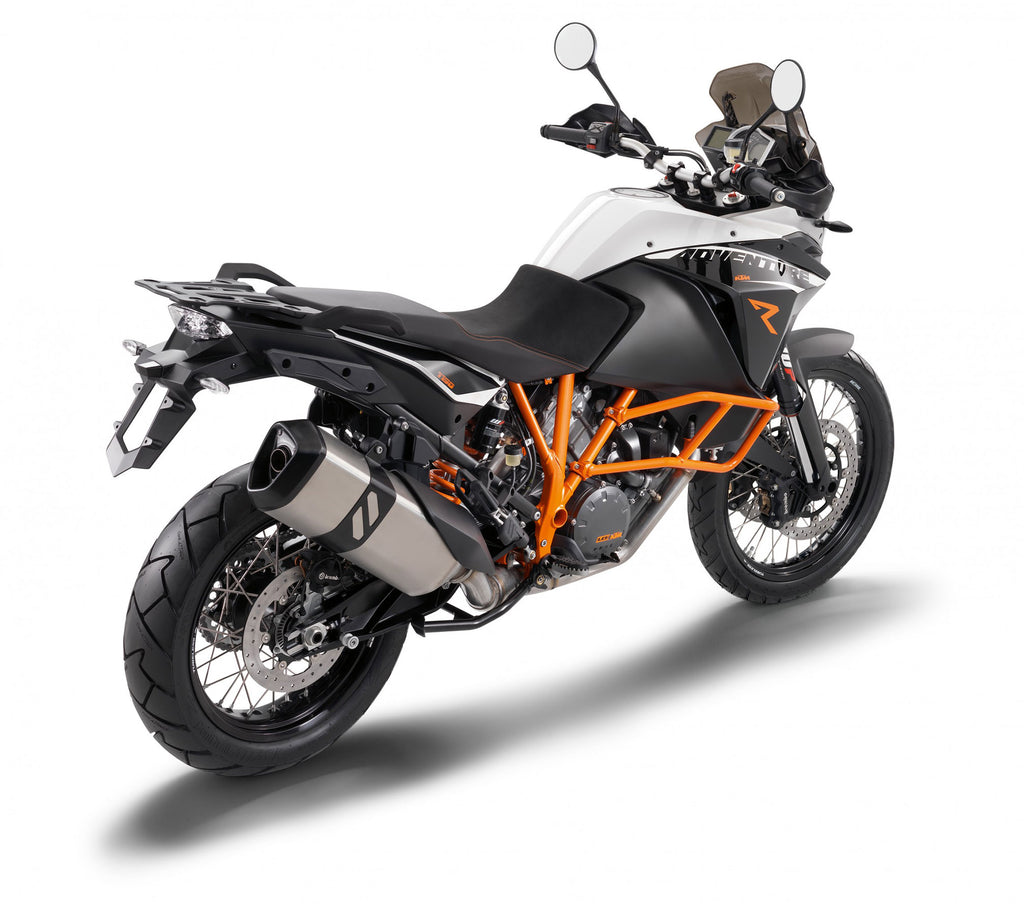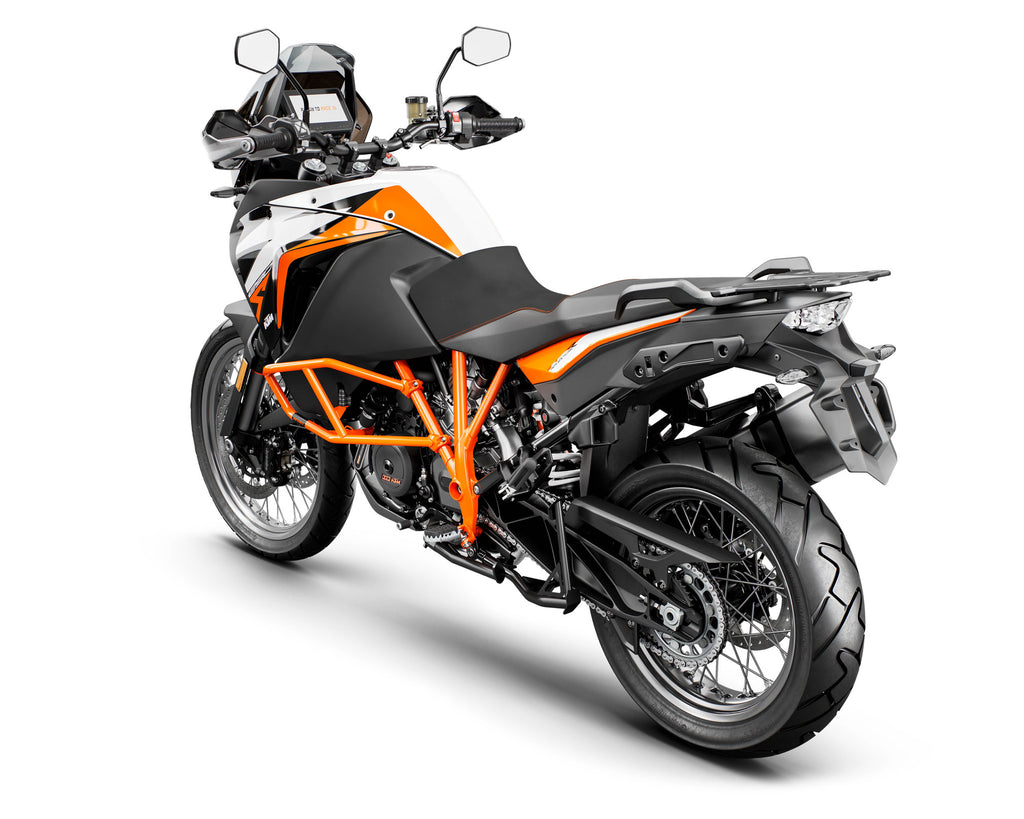KTM 1290 Super Adventure R Vs 1190 Adventure R: What’s Better?

When KTM decides to pull out all the stops, it does so in a big way – literally – in the form of the 1290 Super Adventure R.
It’s big. It’s bad. And it’s ready to take you anywhere in tire-shredding bliss.
But wait a minute; didn’t KTM’s 1190 Adventure already do that? It did. The 1290 Super Adventure version does it better.
What’s changed? Come along as we explain all the changes that went into the 1290 to make it a better motorcycle.
Engine
The obvious first place to start is the engine. Say goodbye to the 1198cc V-Twin from the 1190 Adventure, and say hello to KTM’s monstrous 1301cc V-Twin found in the Super Duke.
It has now been massaged for what KTM calls “travel enduro” duty. Don’t worry, though. Its signature character hasn’t changed, and KTM says it still develops a whopping 160 hp and an incredible 103 lb-ft of torque.
There are four valves per cylinder head, two camshafts per head, and two spark plugs in each head as well for a more complete burn. Diamond-like Coating on the cam followers and friction-reducing finishes on the forged pistons help the engine operate more efficiently, too.
Controlling it all is a ride-by-wire system that eliminates the need for traditional throttle cables and offers excellent power delivery.
Despite the 1290’s incredible performance, KTM has managed to space out service intervals for the engine every 15,000 km, or a little more than 9,000 miles.
In the dirt, having all that power might actually be a challenge to put to the ground (which is where the different ride modes you get from the ride-by-wire help), but on the road, all that grunt will move you along as fast as you’d like. The Pasch slipper clutch will help keep the rear tire under control and avoid excessive wheel hop under hard braking or rough downshifts.
Suspension
It would be silly to think KTM simply stuffed a bigger engine into the 1290 Super Adventure and walked away. The makeover from 1190 to 1290 involves the complete motorcycle, and in the R trim, this goes a step further.
In traditional KTM style, the frame is a Chromoly steel trellis type that’s laser cut and welded together by robots. The bolt-on subframe is nice in the event of a crash since you can easily remove it, fix it, or replace it with another one. The die-cast swingarm straddles the line between stiffness, stability, and having the right amount of flex to give the rider feedback.

Rake measures at 26 degrees, with trail at 4.8 inches. Combined with the 59.3-inch wheelbase, and you have a sport road bike considering the Super Adventure is not-at-all a sportbike.
A 48 mm inverted WP fork sits up front, with what KTM calls “extra stiff” springs. We don’t know exactly what that means in terms of spring rates, but we do know it’s ready to handle the extreme conditions adventure bikes face once taken off-road.
In the back, a WP PDS shock handles whatever jolts the rear might take. Both the fork and shock are fully adjustable, and both have 220 mm of suspension travel. Rounding out the package is a WP steering damper to help keep the front end under control and prevent excessive headshake.
For the serious off-roader, the 21-inch front wheel and 18-inch rear combo provide all kinds of tire choices. The stock rubber is pretty tame since it’s a combined dual-purpose tire, but aftermarket options are immense.
This set of hoops is wire-spoked and tubeless, saving weight while retaining strength, and the lack of a tube makes tire changes easier.
Brakes
Bringing the 1290 Super Adventure R down to a stop are Brembo four-piston, radial-mount calipers, mated to twin 320 mm discs. The rear features a 267 mm disc.
For additional safety, the Bosch 9M+ Cornering ABS is able to reduce wheel lockup under braking while leaned over – the first time this kind of technology has been available on a production motorcycle. More on the system can be found below.
Electronics
Modern motorcycles are littered with electronics to make the ride easier and safer. The 1290 Super Adventure R is no exception. We’ve already mentioned the Bosch C-ABS system above, but that’s just scratching the surface of what the 1290 Super Adventure R comes with. Here’s a brief overview:
- MTC (Motorcycle Traction Control): You’re likely familiar with basic traction control by now, but the 1290’s system takes it a step further because it is a lean-angle sensitive system, able to react to unwanted tire spin in milliseconds while also taking the motorcycle’s lean angle into account. There are four different settings depending on the Ride Mode (Street, Sport, Rain, Offroad) – and the ability to turn MTC off altogether, if you prefer.
- Offroad Ride Mode: As the name suggests, Offroad Ride Mode optimizes the bike for riding in the dirt. With so much power on tap, you run the risk of spinning the rear instantly instead of getting traction, and the off-road environment can make it tricky to modulate the throttle yourself. In this mode, the ride-by-wire limits the throttle response and peak power. As counterintuitive as it sounds, it actually helps put control of the motorcycle back in the rider’s hands. Additionally, rear ABS is turned off, so you can use the rear brake effectively. However, ABS stays on in the front for a little peace of mind.
- Offroad Traction Control: If your eyes immediately widened with concern with the thought of reduced power in the Offroad Ride Mode, fear not. Don’t forget KTM made its name in the dirt, so not being able to spin the tire is not an option. This is where Offroad Traction Control comes in. Here, the traction control lets you spin the tire considerably – KTM says “double rear wheel speed” or “100% slippage” – to allow you to point the Super Adventure R where you want it, or to look like a drift hero, without going overboard.
- Offroad ABS: Like the Offroad Traction Control, Offroad ABS has been optimized, too. We mentioned before how rear ABS is turned off in this mode so you can slide or pivot the bike. We also mentioned that the front ABS stays on, but it intervenes later than on the street. Brake modulation is also different from the street settings to help the rider find grip on loose surfaces.
- KTM MyRide: Welcome to the 21st century. With KTM MyRide, you can connect your smartphone to the bike, allowing you to receive phone calls, play music, and use the optional navigation app.
- Dashboard: The control panel to access everything listed above is the super elaborate, yet super elegant, 6.5-inch TFT color display. The anti-glare surface means you can see all the important information on the screen even in direct sunlight. The dashboard shows you all the usual things like speed, rpm, fuel level, and gear position, but it also displays the different ride modes, ambient air and oil temps, voltage, trip info, average speed, and fuel consumption. You’ll also see the range and the distance until the next service is required.
- Hill Hold Control (optional): If you’ve ever come to a stop on an incline with a giant touring bike that’s loaded to the max, you’ll understand the trepidation that comes next once it’s time to get going again. That fear increases exponentially if you have a passenger along. With the optional Hill Hold Control, the Super Adventure R will automatically deploy the rear brake to prevent you from rolling backward. All you have to do is focus on modulating the throttle and clutch to start rolling forward.

KTM Adventure Other Details
Are you not yet impressed with the 1290 Super Adventure R? With all that it has to offer it’s hard not to be. However, apart from all the big improvements above, here are some of the finer details you’ll find.
Starting with the lights, you’ll find the 1290 gets the stacked vertical LED headlights, the design being a cue found across the entire KTM range. What’s more, there are even LED cornering lights that help light the way around the next bend.
Considering the kind of on-road and off-road riding the Super Adventure might face, the risk of a slow tire puncture is pretty high. Thankfully, there’s an onboard tire pressure monitoring system to keep an eye on the air in each tire and alert you if things are looking awry.
You’ll find other nice details like the automatic turn indicator return, which cancels the turn indicators after 10 seconds of movement and 150 meters of riding distance – so you never look like a dunce for forgetting to turn your indicators off again.
A phone pocket beside the dashboard, with a USB socket to keep it charged. If the phone is paired to the bike, you can still respond to incoming calls or control your music, all from the handlebar controls.
Lastly, there’s the fuel tank. With a capacity of 23 liters (or 6.1 gallons), you’ll be able to travel far and wide before having to worry about your next fill-up. And isn’t that the point of adventure travel?
Concluding Thoughts
As you can see, KTM went all-out when designing the 1290 Super Adventure R. More than just an 1190 with a bigger engine, the combined upgrades turn the 1290 into, arguably, the king of the pack when it comes to large-displacement, mega-adventure bikes.
Its combination of monstrous power with sophisticated chassis dynamics and electronics make it hard to beat on- or off-road. Of course, Triumph and BMW might disagree.

